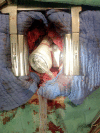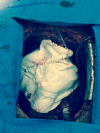Past and Present of Total Artificial Heart Therapy: A Success Story
- PMID: 26343363
- PMCID: PMC4571828
- DOI: 10.12659/MSMBR.895418
Past and Present of Total Artificial Heart Therapy: A Success Story
Abstract
The totally artificial heart (TAH) is among the most prominent medical innovations of the 21st century, especially due to the increasing population with end-stage heart failure. The progressive course of the disease, its resistance to conventional therapy, and the scarcity of hearts available for transplantation were the prime impetus for developing a TAH, especially when other options of mechanical circulatory assist devices are exhausted. In this review, we narrate the history of TAH, give an overview of its technology, and address the pros and cons of the currently available TAH models in light of published clinical experience.
Figures



Similar articles
-
Cardiac prosthesis as an advanced surgical therapy for end-stage cardiac patients: current status and future perspectives.J Med Dent Sci. 2000 Sep;47(3):151-65. J Med Dent Sci. 2000. PMID: 12160228 Review.
-
Total artificial heart.Best Pract Res Clin Anaesthesiol. 2012 Jun;26(2):147-65. doi: 10.1016/j.bpa.2012.04.002. Best Pract Res Clin Anaesthesiol. 2012. PMID: 22910087 Review.
-
The evolving role of the total artificial heart in the management of end-stage congenital heart disease and adolescents.ASAIO J. 2015 Jan-Feb;61(1):8-14. doi: 10.1097/MAT.0000000000000156. ASAIO J. 2015. PMID: 25248044 Review.
-
Beyond implantable first generation cardiac prostheses for treatment of end-stage cardiac patients with clinical results in a multicenter.Ann Thorac Cardiovasc Surg. 2002 Oct;8(5):253-63. Ann Thorac Cardiovasc Surg. 2002. PMID: 12472419 Review.
-
Role of total artificial heart in the management of heart transplant rejection and retransplantation: case report and review.Clin Transplant. 2013 Jul-Aug;27(4):E348-50. doi: 10.1111/ctr.12146. Epub 2013 May 31. Clin Transplant. 2013. PMID: 23725400 Review.
Cited by
-
Concurrent Left Ventricular Assist Device (LVAD) Implantation and Percutaneous Temporary RVAD Support via CardiacAssist Protek-Duo TandemHeart to Preempt Right Heart Failure.Med Sci Monit Basic Res. 2016 May 5;22:53-7. doi: 10.12659/MSMBR.898897. Med Sci Monit Basic Res. 2016. PMID: 27145697 Free PMC article. Review.
-
Pulsatile Support Mode of BJUT-II Ventricular Assist Device (VAD) has Better Hemodynamic Effects on the Aorta than Constant Speed Mode: A Primary Numerical Study.Med Sci Monit. 2016 Jul 1;22:2284-94. doi: 10.12659/msm.896291. Med Sci Monit. 2016. PMID: 27363758 Free PMC article.
-
Comparison of SynCardia total artificial heart and HeartWare HVAD biventricular support for management of biventricular heart failure: a systematic review and meta-analysis.Ann Cardiothorac Surg. 2020 Mar;9(2):69-80. doi: 10.21037/acs.2020.03.07. Ann Cardiothorac Surg. 2020. PMID: 32309154 Free PMC article.
-
Preliminary Results From the C-Pulse OPTIONS HF European Multicenter Post-Market Study.Med Sci Monit Basic Res. 2016 Feb 18;22:14-9. doi: 10.12659/MSMBR.896959. Med Sci Monit Basic Res. 2016. PMID: 26887528 Free PMC article. Clinical Trial.
-
Advancements in mechanical circulatory support for patients in acute and chronic heart failure.J Thorac Dis. 2017 Oct;9(10):4070-4083. doi: 10.21037/jtd.2017.09.89. J Thorac Dis. 2017. PMID: 29268418 Free PMC article. Review.
References
-
- Adler ED, Goldfinger JZ, Kalman J, et al. Palliative care in the treatment of advanced heart failure. Circulation. 2009;120(25):2597–606. - PubMed
-
- Costanzo MR, Mills RM, Wynne J. Characteristics of “stage D” heart failure: insights from the Acute Decompensated Heart Failure National Registry Longitudinal Module (ADHERE LM) Am Heart J. 2008;155:339–47. - PubMed
-
- Gass AL, Emaminia A, Lanier G, et al. Cardiac Transplantation in the New Era. Cardiol Rev. 2015;23(4):182–88. - PubMed
Publication types
MeSH terms
LinkOut - more resources
Full Text Sources
Medical
Miscellaneous

